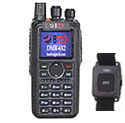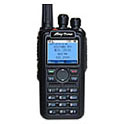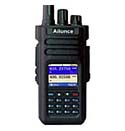Product Review
DMR Handheld
TDMA Tier 2 / 3
VHF or UHF
Part 90 IP-67
July 2018

|
Excera EP-5800
The Excera EP-5800 is a DMR Tier 2 and Tier 3 commercial trunking radio that easily adapts to amateur radio use. It was introduced to the DMR world in late 2017. In the Box Included with the radio are the: - Li-Ion Battery (7.2V 2000/2400mAh) - Belt clip - User Guide – English - Charger base & AC adapter - Antenna – 3.9" (9.8cm) ` - Lanyard General Description - VHF or UHF - Tier 2 DMR, Tier 3 Trunking, and Analog (WB and NB) - Size: 4.5 * 2.1 * 1.2" (115*54*30mm) - Weight: 10.6oz (300g) w/ant & 2400mAh battery - 136-174 400-470 MHz - CTCSS/DCS DTMF/2TONE/5TONE - GPS (optional) - 1.0w / 4.0w transmit - 1024 channels - 32 Zones (up to 32 channels per zone) - 1024 contacts - Part 90 compliant - 2AE6CEP5800U1 Dec 2017 Transmitter The frequency range of the EP-5800 is either VHF 136-174 or UHF 400-470 MHz and supports both DMR and Analog (wideband and narrowband). The power levels were right where they should be at 1.1W on low power and 4.0W on high. My audio reports on both a DMR hotspot and the local repeaters were excellent. Audio levels for both the internal and external Spkr/Micr can be adjusted from 0.0 to 20dB in .5dB steps from via the software. I use the mid level of 12.5db gain and the reports were excellent. Full gain (20db) was much to hot. For the power levels listed below, I used a calibrated Bird Termaline wattmeter.
Receiver and Audio The receiver sensitivity and selectivity is excellent on both digital and analog. The receiver audio amp is .5W, but still loud enough to produce plenty of smooth and clear audio. The volume control range is adjustable. For daily use, I set mine to the full range. (Min=0, Max=8). If you want to use this in the house, you may want to reduce the range so maximum volume is relatively soft. (Min=0, Max=4) Enclosure The EP-5800 case has a solid feel and weight, and fits the hand well. It weighs in at 10.6oz (300g) with both the battery and antenna attached. Battery removal requires a push of the release on the bottom of the case. A smooth easy upward pull removes the battery from the radio. No battery sliding or pushing is required. The radio has 3 programmable keys. Two on the side below the PTT button and one on the top.
I found the keypad buttons to be rather unique. Rather than traditional rubberized keys, these were plastic keys with a very light but positive touch. The keypad format as shown below is three across and four down, putting the zero (0) at the bottom of the keypad. The PTT button, also plastic, responds to the same light as the keypad.
Antenna The UHF antenna measures 3.9" (9.8cm), however, when I tried to do the power level checks, I noticed something a little odd about the antenna connector. Rather than a standard SMA connector, the radio uses an RP-SMA-Male. Notice the center pin in the connector below. Finding an adapter was not difficult, but a replacement antenna might be a challenge.
Display The radio has a basic LCD which makes perfect sense for a commercial grade radio. In an EmComm situation, the Freq, CC, TS, TG and callsign is really not necessary. What is critical is that the communications cannot fail. Basic screen displays are shown below. Again, very basic, but gets the job done. The volume indicator was interesting as it shows level on a circular scale ranging from 1 to 32.
Software Excera software is one of their strong points. If you are familiar with DMR code plugs, you know that sequencing of data can a weak point. Deleting data not an issue, however new data is normally added to the end of the list. With the Excera software, as with many commercial models, I can easily insert new data by highlighting an existing channel and selecting Insert Above or Insert Below. After the new channel is created, I can now Copy/Paste the data from a similar channel into the new position. Adding a new repeater or channels can be done in minutes while retaining a manageable order. The only thing I found slightly annoying was the loud musical tones at power On/Off. The only way it can be silenced is by turning off all sounds. There is no standalone on/off option for this.
For Tier 3 applications, the 5800 can handle both DMR and MPT formats.
As additional features and future refinements are developed, the radio firmware can be updated. Programming Cable The EP-5800 programming cable has the UART chip inside the radio, so the cable itself is straight through, so there is no circuitry inside the cable itself. The driver loads automatically when the cable is attached. The connector has a unique way of attaching to the case. The top of the connector slides into a slot at the top of the case. To lock the connector into place, I simply push the bottom of the connector flush to the case and slide the bottom of the connector down to lock it into place. There are no screws involved. The connector design is very characteristic of radios with an IP-67 waterproof rating.
Battery and Charger The included battery is 7.2V at 2000/2400mAh. The charger base requires a 12vdc wall wart (included). The LED is Red when charging, Green when either fully charged or idle. The battery easily charges to full capacity with an overnight charge. What is Tier 3 Tier 3 pertains to a privately licensed network system used when a standard two timeslot DMR can no longer meet the demands of a growing company or service. An example would be a Countywide 911 system where a simple Tier 2 network cannot provide the network capacity for high activity area wide simultaneous transmissions. Tier 3 allows for multiple repeaters to be networked to pass Voice, Data (Scada), Group and Private Messaging via one or all repeaters simultaneously. These repeaters can be networked via microwave mesh networks as well as IP. Options There are options available as modules that can expand base model. These options can be purchased separately if desired: - Man Down using GPS - Man Down using Glonass - Man Down using BeiDou - Bluetooth module Conclusion Much like its big brother, the Excera EP-8100, the EP-5800 is being built primarily for the commercial market. The basic Tier 2 works perfectly as a DMR transceiver. It may be a while before Tier 3 trunking becomes an amateur standard. If you're looking for a commercial FCC Part 90 radio with excellent software, this handheld may be one to consider. The obvious pros are the following: - Construction - Tier II / III DMR - FCC Part 90 certified - IP-67 Concerns: - Antenna connection is RP-SMA - Accessories are unique to this radio For more information: North America, Latin America, Europe: EXCERA General Sales: EXCERA Brochures and information available HERE Note: This equipment was loaned to me by a friend. This is an unbiased review. All findings are factual based my personal experience.
|
BTECH  DMR6X2 PRO Dual Band (Review) Anytone  D878UV II+ Dual Band (Review)  D578UV Series Mobiles Hotspot  SkyBridge MAX (Review) Ailunce  HD1 / GPS (Review) Amplifiers  BTECH DMR Amps UHF VHF (Review) Repeaters  Ham / GMRS Commercial Repeaters Duplexers |















